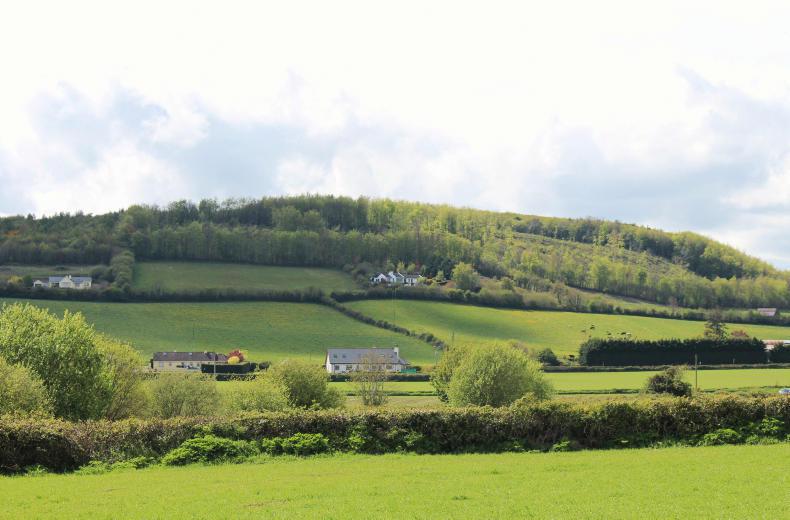IFA farm forestry chair Pat Collins insists “that farmers must be paid on all land they are obligated to set aside under the Afforestation Scheme”.
He said: “Environmental requirements for afforestation (ERA), which came into effect last December, have been shown to increase the areas of biodiversity enhancement (ABE) on certain sites beyond the eligible 15% that can be claimed under the Afforestation Scheme.”
The ERA draws together the different types of setbacks. They also introduce, in certain circumstances, new setbacks and distance increases in some existing setbacks.
Although the setback distance for most sites has not changed, there have been changes on some sites such as peats and catchment areas of “high status objective waterbodies” which require increased setbacks of 20 to 25 metres.
“However, owners can opt for native woodland planting on part of their application to reduce this setback by 10 metres, availing of higher premiums in the process,” said a Department of Agriculture, Food and the Marine spokesperson.
“This option may not be feasible on all sites, but where it is, it provides a mechanism to reduce the likelihood of applications exceeding the 15% upper threshold regarding ABEs,” he maintained.
“The Department is committed to continuing to pay both forestry grants and premiums on the 15% unplanted area in new forestry plantations,” he said.
“In a minority of cases, situations arise whereby the environmental sensitivities in an application may require ABEs greater than 15%. In these situations, the landowner may exclude part of the unplantable area from the forestry plantations.”
 Pat Collins (pictured) said that this situation is unacceptable. “The Government cannot expect farmers to set aside land for the enhancement of the environment and not be compensated for the provision of environmental public goods, such as habitat protection and clean water,” he said.
Pat Collins (pictured) said that this situation is unacceptable. “The Government cannot expect farmers to set aside land for the enhancement of the environment and not be compensated for the provision of environmental public goods, such as habitat protection and clean water,” he said.
“Farmers must receive a payment on all land to compensate them for the loss of earnings and additional management costs that they will incur due to these requirements.”
He said that the commercial value of forests is continually being eroded and this is making the scheme less attractive.
“It is well documented that the primary motive for farmers planting is timber production. These requirements have the potential to reduce productive area and forest premium payments for farmers,” said Collins.
“The Department does not believe that the changes to setbacks introduced by the new environmental requirements will reduce the productive area of afforestation applications generally,” said the spokesperson.
“Setback increases are targeted mainly at watercourses and clarification has been given regarding situations where setbacks are not required.”
“The IFA has written to Andrew Doyle, Minister of State for Forestry, to outline the IFA’s position that farmers must receive a payment on all land to compensate them for the loss of earnings and additional management costs that they will incur due to these requirements,” said Pat Collins.
Bioenergy conference seeks action on renewable energy
The bioenergy conference, which takes place in Castleknock Hotel and Country Club, Dublin, on Thursday 9 February is timely. It coincides with the Department of Communications, Climate Action and Environment (DCCAE) call for submissions on the best design options for a new Renewable Heat Incentive (RHI) in Ireland. Written submission will be accepted up to 3 March. .
Commercial business development manager at Coillte Forest Des O’Toole welcomed the Department’s announcement, “as an RHI has environmental and employment benefits, as well as reducing Ireland’s high dependence on imported oil”.
Currently, Ireland has an overall renewable market share of 8.7%, which includes 6.5% of heat demand. The Irish Government is committed to delivering 16% renewable energy by 2020, including 12% for heat. The DCCAE estimates that Ireland will miss the target by 2% to 2.5%, although many observers, including Des, maintain that it will be greater.
Minister Denis Naughten, will open the conference, organised by the Irish BioEnergy Association (IrBEA). This year, the audience will be hoping for action as progress on renewable energy has been extremely disappointing, especially under the watch of his predecessors Ministers Rabbitte and White.
Ireland lags well behind most of the EU member states, especially Denmark. The EU renewable energy target for Denmark is 30%, but the Danes plan to achieve 33% renewables by 2020, three times higher than Ireland.
 “It’s imperative that the Irish Government develops an energy policy that allows for greater growth in the bioenergy sector,” said IrBEA’s Noel Gavigan (pictured). “The event has a strong lineup of speakers who will present industry models, policy perspectives and investment opportunities,” he said.
“It’s imperative that the Irish Government develops an energy policy that allows for greater growth in the bioenergy sector,” said IrBEA’s Noel Gavigan (pictured). “The event has a strong lineup of speakers who will present industry models, policy perspectives and investment opportunities,” he said.
Speakers include IrBEA president and director Action Renewables Michael Doran, CEO Coillte Fergal Leamy, CEO Sustainable Energy Authority of Ireland Jim Gannon, principal consultant BioXL Tom Bruton, principal scientist Fehily Timoney & Co Derek Milton, and associate professor Aalborg University, Copenhagen, David Connolly.
Booking and further information at www.irbea.org or contact Teresa O’Brien at contact@irbea.ie.
IFA farm forestry chair Pat Collins insists “that farmers must be paid on all land they are obligated to set aside under the Afforestation Scheme”.
He said: “Environmental requirements for afforestation (ERA), which came into effect last December, have been shown to increase the areas of biodiversity enhancement (ABE) on certain sites beyond the eligible 15% that can be claimed under the Afforestation Scheme.”
The ERA draws together the different types of setbacks. They also introduce, in certain circumstances, new setbacks and distance increases in some existing setbacks.
Although the setback distance for most sites has not changed, there have been changes on some sites such as peats and catchment areas of “high status objective waterbodies” which require increased setbacks of 20 to 25 metres.
“However, owners can opt for native woodland planting on part of their application to reduce this setback by 10 metres, availing of higher premiums in the process,” said a Department of Agriculture, Food and the Marine spokesperson.
“This option may not be feasible on all sites, but where it is, it provides a mechanism to reduce the likelihood of applications exceeding the 15% upper threshold regarding ABEs,” he maintained.
“The Department is committed to continuing to pay both forestry grants and premiums on the 15% unplanted area in new forestry plantations,” he said.
“In a minority of cases, situations arise whereby the environmental sensitivities in an application may require ABEs greater than 15%. In these situations, the landowner may exclude part of the unplantable area from the forestry plantations.”
 Pat Collins (pictured) said that this situation is unacceptable. “The Government cannot expect farmers to set aside land for the enhancement of the environment and not be compensated for the provision of environmental public goods, such as habitat protection and clean water,” he said.
Pat Collins (pictured) said that this situation is unacceptable. “The Government cannot expect farmers to set aside land for the enhancement of the environment and not be compensated for the provision of environmental public goods, such as habitat protection and clean water,” he said.
“Farmers must receive a payment on all land to compensate them for the loss of earnings and additional management costs that they will incur due to these requirements.”
He said that the commercial value of forests is continually being eroded and this is making the scheme less attractive.
“It is well documented that the primary motive for farmers planting is timber production. These requirements have the potential to reduce productive area and forest premium payments for farmers,” said Collins.
“The Department does not believe that the changes to setbacks introduced by the new environmental requirements will reduce the productive area of afforestation applications generally,” said the spokesperson.
“Setback increases are targeted mainly at watercourses and clarification has been given regarding situations where setbacks are not required.”
“The IFA has written to Andrew Doyle, Minister of State for Forestry, to outline the IFA’s position that farmers must receive a payment on all land to compensate them for the loss of earnings and additional management costs that they will incur due to these requirements,” said Pat Collins.
Bioenergy conference seeks action on renewable energy
The bioenergy conference, which takes place in Castleknock Hotel and Country Club, Dublin, on Thursday 9 February is timely. It coincides with the Department of Communications, Climate Action and Environment (DCCAE) call for submissions on the best design options for a new Renewable Heat Incentive (RHI) in Ireland. Written submission will be accepted up to 3 March. .
Commercial business development manager at Coillte Forest Des O’Toole welcomed the Department’s announcement, “as an RHI has environmental and employment benefits, as well as reducing Ireland’s high dependence on imported oil”.
Currently, Ireland has an overall renewable market share of 8.7%, which includes 6.5% of heat demand. The Irish Government is committed to delivering 16% renewable energy by 2020, including 12% for heat. The DCCAE estimates that Ireland will miss the target by 2% to 2.5%, although many observers, including Des, maintain that it will be greater.
Minister Denis Naughten, will open the conference, organised by the Irish BioEnergy Association (IrBEA). This year, the audience will be hoping for action as progress on renewable energy has been extremely disappointing, especially under the watch of his predecessors Ministers Rabbitte and White.
Ireland lags well behind most of the EU member states, especially Denmark. The EU renewable energy target for Denmark is 30%, but the Danes plan to achieve 33% renewables by 2020, three times higher than Ireland.
 “It’s imperative that the Irish Government develops an energy policy that allows for greater growth in the bioenergy sector,” said IrBEA’s Noel Gavigan (pictured). “The event has a strong lineup of speakers who will present industry models, policy perspectives and investment opportunities,” he said.
“It’s imperative that the Irish Government develops an energy policy that allows for greater growth in the bioenergy sector,” said IrBEA’s Noel Gavigan (pictured). “The event has a strong lineup of speakers who will present industry models, policy perspectives and investment opportunities,” he said.
Speakers include IrBEA president and director Action Renewables Michael Doran, CEO Coillte Fergal Leamy, CEO Sustainable Energy Authority of Ireland Jim Gannon, principal consultant BioXL Tom Bruton, principal scientist Fehily Timoney & Co Derek Milton, and associate professor Aalborg University, Copenhagen, David Connolly.
Booking and further information at www.irbea.org or contact Teresa O’Brien at contact@irbea.ie.
 Pat Collins (pictured) said that this situation is unacceptable. “The Government cannot expect farmers to set aside land for the enhancement of the environment and not be compensated for the provision of environmental public goods, such as habitat protection and clean water,” he said.
Pat Collins (pictured) said that this situation is unacceptable. “The Government cannot expect farmers to set aside land for the enhancement of the environment and not be compensated for the provision of environmental public goods, such as habitat protection and clean water,” he said.  “It’s imperative that the Irish Government develops an energy policy that allows for greater growth in the bioenergy sector,” said IrBEA’s Noel Gavigan (pictured). “The event has a strong lineup of speakers who will present industry models, policy perspectives and investment opportunities,” he said.
“It’s imperative that the Irish Government develops an energy policy that allows for greater growth in the bioenergy sector,” said IrBEA’s Noel Gavigan (pictured). “The event has a strong lineup of speakers who will present industry models, policy perspectives and investment opportunities,” he said.





 This is a subscriber-only article
This is a subscriber-only article










SHARING OPTIONS: